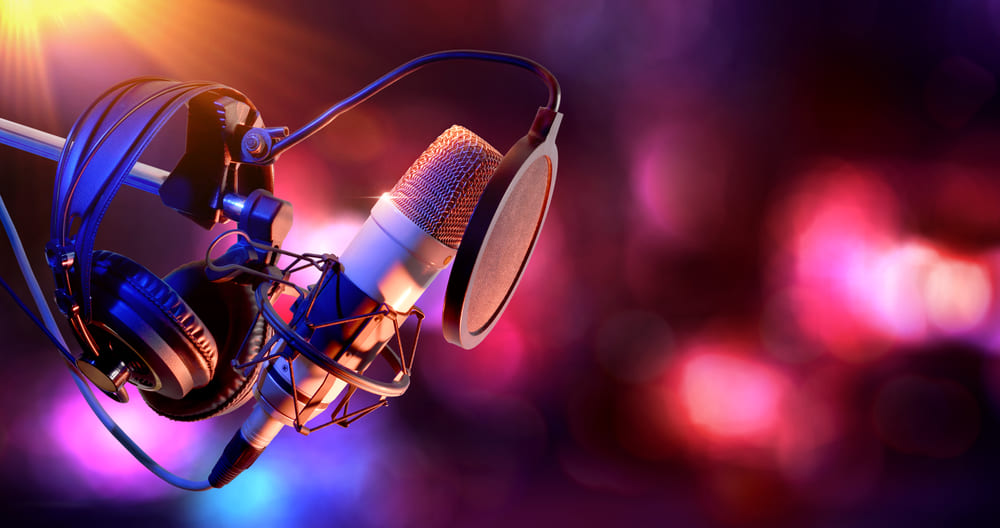If you want to record songs at home and you have no idea about which microphone to use, then here I am to help you out, covering from the cheapest to the most expensive microphone you can use to record your song at home. Frankly speaking, your performance is what matters. No matter which microphones you use for singing, your songs will sound amazing, but the fact cannot be ignored that a good microphone for singing will make your vocals sound pleasant and soothing to the listeners.
Mugafi Ved – AI Storywriting tool
Types of Microphone
Before discussing various microphones for singing, let us understand the different types of microphones.
Mugafi Ved – AI copilot for writers
USB Microphone
If you need a convenient microphone for singing at home, it is a great choice. A USB microphone has an interface built in itself, which enables you to plug it directly into your USB port. A USB Microphone also has amplifications so as to adjust the signals at the right levels. There are a plethora of options when you use a USB microphone for singing at home.
The problem with a USB microphone is that you cannot replace or change it and also cannot connect other microphones for singing until and unless you purchase new USB microphones for singing. For this reason, I rather advise you to invest in purchasing an interface, or you can also go with a dynamic microphone, which is inexpensive too. While you are using the dynamic microphone for singing at home, it is very convenient to jump or upgrade to the condenser as per your need.
Dynamic Microphone
A dynamic microphone is very useful and makes a lot of sense for singing at home. It is a great microphone for singing as it features a cardioid pickup pattern. Usually, you’ll use a dynamic mic when you wish to record any instrument or vocalist with either a broader range in amplitude (volume) or that is really loud. They can withstand higher SPLs without getting damaged or distorting inside.
Condenser Microphone
It will be best to choose a condenser microphone for singing. If you have a good budget, then you should definitely invest in a condenser microphone for singing at home, and I promise you will not regret investing in it. Also, whenever you are using a condenser microphone at home for recording, then do purchase a Pop Filter that will improve your vocal quality, making it clear as it eliminates breathing noises and extra background sounds. Condenser microphones overcome the flaws of the dynamic microphone as they specialize in recording small details when coupled with phantom power.
These were three main features or types you can say when it comes to different types of microphones.
Commonly used Microphone for Singing at Home
Let us discuss some of the most widely used microphones for singing at home or studio.
- Shure MV7 USB
Shure MV7 Podcast Mic is easy to use. It has an in-built DSP, which is adjustable as per the requirement with high quality and dual-format, which means you can use it as either a USB Mic or as an XLR Mic or even as both at the same time.
- AKG Lyra
The AKG Lyra is marketed as an ‘Ultra-HD Multimode USB microphone.’ It is very flexible in its use. You just have to plug it into your computer, load up your audio software, and here you are, good to go.
- Blue Yeti
A blue yeti USB Mic is one with a switchable pickup pattern. This microphone looks super cool when kept at your desk. A blue yeti pro USB is the upper version of a blue yeti mic with some additional benefits.
- RODE NT1
A is one of the best condenser microphones for beginners. This microphone has a large-diaphragm transducer type (25 mm), with a frequency response of 20Hz to 20 kHz. The Rode NT1-A has a cardioid polar pattern and a good frequency response that focuses on your performance and captures minutes of the details with no alterations.
- Shure SM7B
This is one of the most widely used microphones for vocal recording.
The Shure SM7B is a favourite among professional musicians because of its dependable performance, premium build quality, and noise-cancelling software that allows for crystal-clear recordings. This microphone is intended for experienced experts and aspiring professionals in the industry; it is not for people just starting out in the recording. All recording ranges benefit greatly from the uniform frequency response, and various responses can be used in other studio applications.
It is the ideal companion for controlled-environment recording. Depending on the intended outcome, users can alternate between the three frequency responses flat, bass roll-off, and presence enhancement.
The high-pass frequency response is advantageous for professional audio mixers. It works wonders for reducing low-frequency electronic hums caused by nearby equipment.
- KU5A microphone
A unique transformer and JFET circuitry are included with the active KU5A. Similar to the A440, R84A, and NUVO ribbon microphones, it has a unique transformer that boosts output while reducing perceptible noise and maintaining impedance. This permits more versatility with various preamps, including those found in audio interfaces, and consistent frequency response. When recording quiet sources like vocals and delicate acoustic guitars, the enhanced output of the KU5A is helpful, and the active circuitry eliminates background noise. Standard 48-volt phantom power is used to operate the KU5A.
- DPA d: facto Vocal Mic
This super-cardioid condenser vocal microphone produces a sound that is incredibly crisp and well-defined. A multipurpose capsule is housed in the d: facto. The super-cardioid capsule can be used with a variety of wireless microphone systems, including Sony, Lectrosonics, Shure, Wisycom, Sennheiser, and more, by utilizing an optional adaptor. You’ll definitely enjoy the super-cardioid polar pattern of the mic on stage because it maximizes gain-before-feedback. The outstanding quality of DPA’s studio microphones is well known. With the DPA d: facto Vocal Mic, you can now achieve that fantastic sound live.
- Audio Technica AT4040 microphone
The AT4040 offers exceptionally low noise, a wide dynamic range, and high-SPL capability for maximum versatility. It combines technical accuracy with creative inspiration. Even under the strict requirements of digital recording systems, this ultra-consistent microphone can be utilized with confidence in a wide range of studio and live miking applications. Transformer-free and symmetrical low-noise circuitry in the AT4040 produces very good transient responsiveness and clean output signals for transparent reproduction of even the most challenging instruments and sound effects.
- Shure KSM32
A side-address, cardioid, single-diaphragm embossed condenser microphone for singing and live sound productions and demanding studio recordings. An open, genuine sounding reproduction of the original sound source is possible with the Shure KSM32 because of its expanded frequency response.
- Neumann TLM 103
The TLM 103’s extraordinarily low self-noise is still hailed as a breakthrough. Technically speaking, a noise level of only 7 dB (A). In other words, the TLM 103 has such low noise levels that even the most subtle differences may be heard. As a result, it is ideal for demanding sample creation and instrumental recordings, as well as high-definition vocal and audio drama productions.
- WA-47
Based on the iconic ’47 that has been utilized on innumerable hit records for the past 50+ years, the WA-47 is an all-vacuum tube, big diaphragm, transformer balanced, multi-pattern (9), large condenser microphone. With exceptional results on voices, acoustic/electric guitars, acoustic/electric basses, drums, piano, strings, brass/woodwind instruments, and a variety of other sources, the WA-47 is ideal for a professional studio home studio, live, and broadcast applications.
- MA-200
The MA-200 is the result of Royer’s more than 20 years of experience designing bespoke microphones. Without the shrillness and high-frequency grunge so frequently heard with contemporary condenser microphones, the large-diaphragm MA-200 provides warm, full-bodied renditions of vocalists and instruments.
| You may also like to read: What is the Best Age to Learn to Sing? |
- TF29 Copperhead
The TF29 Copperhead is a development of the CU-29 Copperhead, a unique TELEFUNKEN Elektroakustik design that won admirers for its unrivalled “quality for price” and natural, un-hyped tone. The TF29 upholds this reputation for exceptional pricing and sonic quality. It is a workhorse microphone that captures voices, electric and acoustic guitar, percussion, and almost any source placed in front of it honestly and correctly.
- Manley Reference Cardioid Tube Microphone
It is the most often used contemporary tube vocal mic worldwide. Top producers and voiceover artists both like the Manley Reference Cardioid Tube Microphone because it has that “complete” sound right out of the box.
This is the standard microphone for singing contemporary pop music; it is adoring, present, and enormous. The Manley Ref C is sometimes called the “Just Add Talent” microphone.
- The Virtual Microphone System
The “VMS” is a hybrid system that makes use of an incredibly transparent condenser microphone, a preamp that is musically neutral, and a cutting-edge digital processing suite that mimics the sound of vintage microphones and preamps. Audio engineers may now access the virtual microphone closet of their dreams for less than $1,000. Thanks to the Virtual Microphone System, which knocks down the barrier separating them from expensive, top-notch audio equipment.
Other Important Links
Learn Lyric Writing from Sameer Anjaan
Learn singing online with Monali Thakur
Join Unlu Lyric Writing Fellowship and Become the next great Lyricist
Join Unlu Community of Lyricists, Singers, Composers, and Producers







